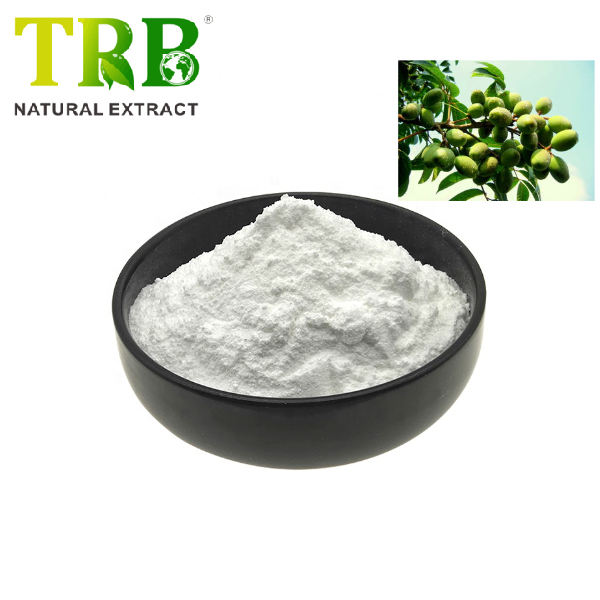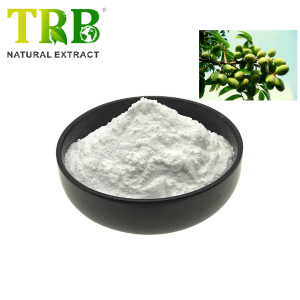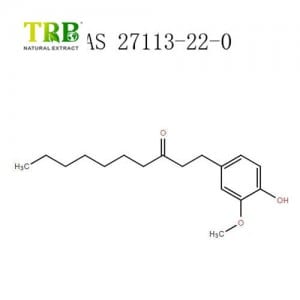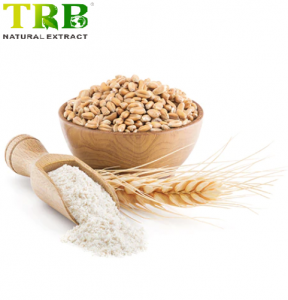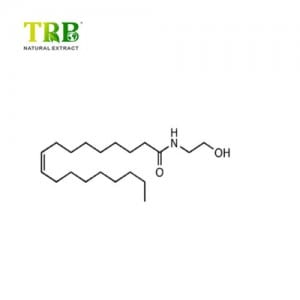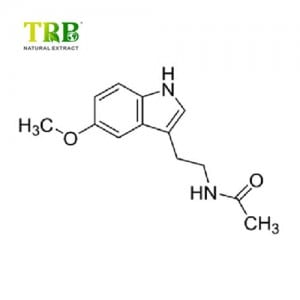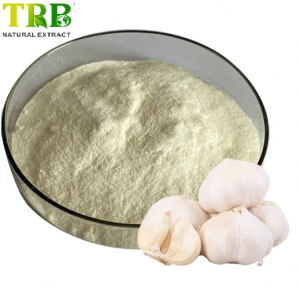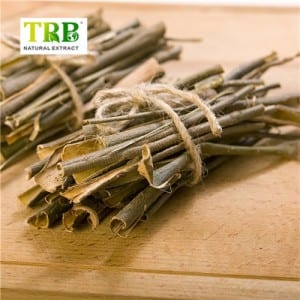Oleanolio rūgštis, kuri yra trys pentacikliniai triterpenoidai, išskirti iš Swertia mileensis gentianaceae augalų, visos žolės arba ligustrų vaisių, su laisvu kūnu ir glikozidais daugelyje augalų.Oleanolio rūgšties augaluose yra platus asortimentas, o vidutinis kiekis yra 0,2–2%.Cucurbitaceae didelis kiekis yra 1,5% ~ kuprotas dugnas 2%, ligustrų vaisių kiekis 0,6% ~ 0,7%.Oleanolio rūgštis yra pentaciklinis triterpenoidinis junginys, išskirtas iš Asteraceae, Syzygium sylvestris arba Ligustrum lucidum genties vaisių.Tai yra kepenų ligų adjuvantas ir kliniškai naudojamas terapinei infekcijai gydyti.Ūminis gelta hepatitas turi akivaizdų poveikį alanino aminotransferazės mažinimui ir pageltimui. Alyvos rūgštis yra pentaciklinis triterpenoidas, išskirtas iš gentianaceae augalo swertia chinensis arba fructus ligustris vaisių.Oleanolio rūgštis plačiai randama augaluose, jos bendras kiekis yra 0,2–2 % [1].Kalabašo dugno kiekis buvo 1,5–2%, o fructus ligustris vaisių – 0,6–0,7%.Oleanolio rūgštis yra baltos spalvos kristalas (etanolis), bekvapis ir beskonis.Nestabilus rūgštims ir bazėms.Lydymosi temperatūra 308 ~ 310 ℃, [alfa] 20 d + 73,3 ° (c = 0,15, chloroformas, netirpus vandenyje, tirpus metanolyje, etanolyje, etilo eteryje, acetone ir chloroforme. Oleanolio rūgštis yra gamtoje paplitęs triterpenoidas, plačiai paplitęs maistiniuose ir vaistiniuose augaluose, susijusiuose su betulino rūgštimi. Jo galima rasti Phytolacca americana (American Pokeweed) ir Syzygium spp.
Nustatyta, kad oleanolio rūgštis pasižymi stipriu anti-ŽIV aktyvumu, o giminingas junginys betulino rūgštis buvo panaudota kuriant pirmąjį komercinį brendimo inhibitorių vaistą.Pirmą kartą jis buvo ištirtas ir išskirtas iš kelių augalų, įskaitant Rosa woodsii (lapai), Prosopis glandulosa (lapai ir šakelės), Phordendron juniperinum (visas augalas), Syzygium claviflorum (lapai), Hyptis capitata (visas augalas) ir Ternstromia gymnanthera (oro). dalis).Jo yra ir kitose Syzygium rūšyse, įskaitant java obuolius (Syzygium samarangense) ir rožių obuolius.
Produkto pavadinimas: oleanolio rūgštis98%
Specifikacija: 98 % pagal HPLC
Botanikos šaltinis:Olea Europea ekstraktas
Cheminis pavadinimas: (3β)-3-hidroksiolean-12-en-28-o rūgštis
CAS Nr.:508-02-1
Naudota dalis: Lapas
Spalva: balti milteliai su būdingu kvapu ir skoniu
GMO būsena: Be GMO
Įpakavimas: 25 kg pluošto statinėse
Laikymas: neatidarytą talpyklą laikykite vėsioje, sausoje vietoje, laikykite atokiai nuo stiprios šviesos
Tinkamumo laikas: 24 mėnesiai nuo pagaminimo datos
Kas yraoleanolio rūgštis?
Oleanolio rūgštis (OA), natūrali hidroksilo pentaciklinė triterpenoidinė rūgštis (HPTA), panaši į betulino rūgštį, ursolio rūgštį;jis turi tokių privalumų kaip antibakterinė, priešuždegiminė, priešnavikinė veikla.

Kur galima rastioleanolio rūgštis?
Oleanolio rūgštis tradiciškai naudojama įvairioms ligoms gydyti, jos randama maiste ir augaluose.
Kai kuriuose vaisiuose, pavyzdžiui, obuoliuose, granatuose, citrinose, mėlynėse, alyvuogėse, taip pat yra oleanolio rūgšties.

| Žolelių pavadinimas | Oleanolio rūgšties kiekis | Bandymo metodas |
| Ligustrum lucidum Ait | 0,8028 % | HPLC |
| Verbena officinalis L | 0,071–0,086 % | HPLC |
| Prunella vulgaris L | 3,47–4,46 % | HPLC |
| Hemsley Chinensis Cogn. | 1,5–2 % | HPLC |
Šiuo metu Kinijos žolėHemsley Chinensis Cognvis dar yra pati komercinė žaliava oleanolio rūgščiai ekstrahuoti.
Hemsley Chinensis Cogn.Įvadas
Hemsleya chinensis Cogn.yra daugiametis vijoklinis augalas, taip pat yra tradicinė kinų medicina.
Šeima: Cucurbitaceae
Tribusas: Gomphogyneae
Gentis: Hemsleya
Rūšis: H. amabilis
Žolė platinama provincijose Guangxi, Sichuan, Guizhou, Yunnan, Hubei ir tt Gimė miško pakraštyje ir slėnio krūmuose apie 2000 metrų aukštyje.
Veikliosios medžiagos: sudėtyje yra Hemslolide Mal、Ma3、H1;Chikusetsusaponin-Iva;dihidrocucurbitacin F-25-acetatas;dilydrocucurbitacin F;oleanolio rūgšties beta-hlukoziloleanolatas;hemsamabilininas A;Cu-curbitacinⅡb-2-beta-D-gliukopiranozidas.
Vaistinės vertės:
Hemsleya chinensis Cogn.daugiausia skirtas detoksikacijai, sterilizacijai, priešuždegiminiam, skrandžio stiprinimui ir skausmo malšinimui.Šiuo metu klinikinėje praktikoje plačiai naudojami ekstraktai, milteliai arba sudėtiniai preparatai, tokie kaip kapsulės, tabletės, virškinimo trakto tabletės ir kt.

Oleanolio rūgšties ekstrahavimas išHemsleya Chinensis Cogn.

Formulės, kurių sudėtyje yra oleanolio rūgšties maisto papilduose
Mes nustatėme, kad oleanolio rūgštis, naudojama sveikatos papilduose, daugiausia gaunama iš trijų rūšių augalų ekstraktų: Loquat lapų ekstrakto, Hemsley Chinensis ekstrakto ir šventojo baziliko ekstrakto.
- Šventojo baziliko milteliai (lapai) (0,4% ursolio rūgšties ir oleanolio rūgšties, 2,0 mg)
- Šventojo baziliko superkritinis CO2 ekstraktas (lapas) (Ocimum tenuiflorum Linn.) (2,5% ursolio rūgšties ir oleanolio rūgšties, 1,5 mg)
- Loquat ekstraktas (vaisiai) (suteikia ursolio rūgšties, oleanolio rūgšties) (standartuota iki ursolio rūgšties porcijoje 125mg)

Oleanolio rūgštis VS ursolio rūgštis
Oleanolio rūgštis (OA) ir ursolio rūgštis (UA) yra natūralūs triterpenoidai, turintys panašią cheminę struktūrą.
Yra žinoma, kad šių triterpenoidų junginių yra vaistinėse žolelėse ir maisto produktuose.
Jie turi daug bendrų farmakologinių savybių: hepatoprotekcinių, priešuždegiminių, antimikrobinių, hipoglikeminių, antimutageninių, anti-ŽIV aktyvų, antioksidacinių ir vaisingumą mažinančių savybių.

OA ir UA skirtumas:
| produkto pavadinimas | Oleanolio rūgštis | Ursolio rūgštis |
| CAS NR. | 508-02-1 | 77-52-1 |
| Pentacikliniai triterpenai | β-Amirinas | α-amirinas |
| Žolelių šaltiniai | Loquat lapas, šventasis bazilikas, rozmarinas, alyvuogių lapas ir kt. | |
| Specifikacijos | 40%, 98% milteliai | 15%, 25%, 50%, 98% milteliai |
| Išvaizda (spalva ir kvapas) | 40 % šviesiai geltonos 98 % baltos spalvos bekvapiai milteliai | 15% -50% rudai geltoni arba geltoni98% balti milteliai |
| Išsiskiriantis | IR: (1355-1392 cm-1) dvi smailės (1245-1330 cm-1) trys smailės BMR: δ (C12)122,1,δ(C13)143.4 | (1355-1392 cm-1) trys viršūnės (1245–1330 cm).-1) trys smailėsδ(C12)125,5,δ(C13)138,0 |
| Dariniai | Oleanolio natrio druska Oleanolio rūgšties fosfato dinatrio druska3-okso oleanolio rūgštis metilo bardoksolonas (CDDO-Me) | Urzolio natrio druska ir jos dikarboksirūgšties pusesterio dariniai Urzolio rūgšties keteno dariniai 3 anglies urzolio rūgštis 3-acetoksiursolio rūgštis |
| Galimas priešvėžinis | UA yra populiaresnis nei OA. | |
Oleanolio rūgšties biologinis aktyvumas
-
Priešnavikinis / priešvėžinis poveikis
Oleanolio rūgšties slopinamasis poveikis kepenų ląstelių karcinomai per ERK-p53 sukeltą ląstelių ciklo sustabdymą ir nuo mitochondrijų priklausomą apoptozę
– Xin Wang, Hua Bai ir kt. Tyrėjai
OA rodė slopinamąjį poveikį HCC, indukuodamas apoptozę ir ląstelių ciklo sustabdymą tiek persodintuose navikuose, tiek HepG2 ląstelėse.
OA sukėlė apoptozę per mitochondrijų kelią, o tai patvirtina rapamicino kelio Akt / žinduolių taikinio slopinimas.
OA sukeltas G2 / M ląstelių ciklo sustabdymas per p21 sąlygojamą ciklino B1 / cdc2 reguliavimą.
OA parodė reikšmingą priešnavikinį aktyvumą HCC in vivo ir in vitro modeliuose.Šie duomenys suteikia naujų įžvalgų apie OA priešnavikinio poveikio mechanizmus.
Be to, tyrimai rodo, kad OA ir jo darinys oleanolio rūgšties metilo esteris taip pat turi įtakos krūties vėžiui, plaučių vėžiui, šlapimo pūslės vėžiui, gimdos kaklelio vėžiui, kasos vėžio ląstelėms...

-
Antimikrobinis aktyvumas
Tikimasi, kad OA pasižymės antimikrobiniu aktyvumu prieš įvairius patogenus, nes jis atlieka gyvybiškai svarbų vaidmenį saugantis nuo patogenų augaluose.
OA parodė vidutinį aktyvumą prieš Staphylococcus aureus ir Bacillus Thuringiensis esant 62,5 µg/mL ir Escherichia coli, Salmonella Enterica ir Shigella dysenteriae esant 31,2 µg/mL mažiausią slopinamąją koncentraciją (MIC).
-
Hepatoprotekcinis gebėjimas
Vienas iš svarbiausių OA biologinių savybių yra kepenų apsauga nuo toksiškumo ir šiuo metu Kinijoje naudojamas kaip nereceptinis vaistas nuo kepenų.
Wistar albinosų žiurkėms buvo naudojamas Flaveria Trinervia OA, kuris turėjo reikšmingą apsauginį poveikį etanolio sukeltam toksiniam poveikiui kepenims, atkurdamas hepatotoksinio serumo žymeklio fermento lygį.Šis tyrimas parodė, kad OA antioksidacinis gebėjimas yra dar vienas galimas jo hepatoprotekcinio gebėjimo mechanizmas.
Oleanolio rūgštis ir jos dariniai

Oleanolio rūgšties klinikiniai tyrimai
Oleanolio rūgštis (gaunama iš alyvuogių), yra apie 500 registruotų klinikinių tyrimų, kurie parodė, kad klinikiniuose tyrimuose ji turėjo teigiamą poveikį lėtinėms inkstų ligoms, 2 tipo cukriniam diabetui ir kai kurioms uždegiminėms ligoms, tokioms kaip artritas.
Klinikinių tyrimų metu populiariausi dariniai yra bardoksolono metilas (CDDO-Me).CDDO-Me buvo įvertintas naviko biopsijose ir gali atlikti svarbų vaidmenį gydant lėtinę inkstų ligą, šiuo metu vertinamas jo poveikis hipertenzijai.
Kinijos farmakopėjos oleanolio rūgšties standartas
| Produkto pavadinimas | Oleanolio rūgštis |
| Identifikavimas | (1) Paimkite 30 mg šio produkto, įdėkite į mėgintuvėlį, įpilkite 3 ml chloroformo, kad ištirptų, įlašinkite du lašus sieros rūgšties, purtykite 5 minutes, chloroformo sluoksnis yra purpuriškai raudonas. |
| (2) Paimkite apie 20 mg šio produkto, įpilkite 1 ml acto rūgšties anhidrido, ištirpinkite šiek tiek kaitinant, įpilkite sieros rūgšties iki purpurinės spalvos ir uždėję patamsinkite. | |
| (3) Paimkite apie 10 mg šio produkto, įpilkite vanilino ledinės acto rūgšties tirpalo (paimkite vanilino 0,5 g, įpilkite 10 ml ledinės acto rūgšties, kad ištirptų) 0,2 ml, įpilkite 0,8 ml perchloro rūgšties ir pakaitinkite keletą minučių. vandens vonelėje.Fuksija, įpilkite 2 ml etilo acetato, purpurinės-raudonos, ištirpinto etilo acetate, dedamas be spalvos. | |
| (4) Šio gaminio infraraudonųjų spindulių sugerties spektras turi atitikti kontrolinį spektrą. | |
| Tyrimo nustatymas | Paimkite 0,15 g šio produkto, tiksliai pasverkite, įpilkite 30 ml etanolio, suplakite, pakaitinkite šilto vandens vonelėje, kad ištirptų, atvėsinkite iki kambario temperatūros, įlašinkite 3 lašus fenolftaleino indikatoriaus tirpalo, pasigaminkite kalio hidroksido tirpalą su etanoliu ( 0,05 mol/L) Nedelsdami titruokite ir pakoreguokite tuščiąjį bandymą.Kalio hidroksido tirpalas (0,05 mol/L) 1 ml etanolio atitinka 22,84 mg C30H48O3. |
Oleanolio rūgšties rekomenduojamos dozės
Pagal Kinijos farmakopėjos standartą, oleanolio rūgšties geriamoji dozė yra 20–80 mg per kartą, 60–240 mg per dieną.
Oleanolio rūgšties šalutinis poveikis
Oleanolio rūgštis dešimtmečius Kinijoje buvo naudojama kaip nereceptinis (OTC) hepatoprotekcinis vaistas.
Perdozavus ar neteisingai, nedaugeliui pacientų atsiranda burnos džiūvimas, viduriavimas, diskomfortas viršutinėje pilvo dalyje ir gali išnykti po simptominio gydymo.
Prieš naudodami šį produktą pasitarkite su gydytoju arba vaistininku.
Funkcija:
1. Oleanolio rūgštis yra palyginti netoksiška, priešnavikinė ir hepatoprotekcinė, taip pat pasižymi antivirusinėmis savybėmis.
2. Nustatyta, kad oleanolio rūgštis pasižymi stipriu anti-ŽIV aktyvumu.
3.Oleanolio rūgštis yra pagrindinė ląstelių apsauga nuo oksidacinio ir elektrofilinio streso.
4.Oleanolio rūgštis turi didelį poveikį gydant virusinį hepatitą, ūminį icterinį hepatitą ir lėtinį hepatitą.
Taikymas:
1. Taikoma maisto srityje, ji gali būti naudojama kaip arbatos žaliava, siekiant sumažinti skreplių susidarymą;
2. Taikomas farmacijos srityje, jis tampa nauju mažo toksiškumo vaistu nuo vėžio;
3. Taikoma kosmetikos srityje, ji gali pagyvinti kraujotaką ir pašalinti gėrimą.
| Daugiau informacijos apie TRB | ||
| Reglamento sertifikavimas | ||
| USFDA, CEP, KOSHER HALAL GMP ISO sertifikatai | ||
| Patikima kokybė | ||
| Beveik 20 metų eksportuojama į 40 šalių ir regionų, daugiau nei 2000 TRB pagamintų partijų neturi jokių kokybės problemų, unikalus valymo procesas, priemaišų ir grynumo kontrolė atitinka USP, EP ir CP. | ||
| Visapusiška kokybės sistema | ||
|
| ▲ Kokybės užtikrinimo sistema | √ |
| ▲ Dokumentų valdymas | √ | |
| ▲ Patvirtinimo sistema | √ | |
| ▲ Treniruočių sistema | √ | |
| ▲ Vidaus audito protokolas | √ | |
| ▲ Suppler audito sistema | √ | |
| ▲ Įrangos patalpų sistema | √ | |
| ▲ Medžiagų valdymo sistema | √ | |
| ▲ Gamybos valdymo sistema | √ | |
| ▲ Pakuočių ženklinimo sistema | √ | |
| ▲ Laboratorinė kontrolės sistema | √ | |
| ▲ Patvirtinimo patvirtinimo sistema | √ | |
| ▲ Reguliavimo reikalų sistema | √ | |
| Valdykite visus šaltinius ir procesus | ||
| Griežtai kontroliuojamos visos žaliavos, priedai ir pakavimo medžiagos. Pageidaujamas žaliavų ir priedų bei pakavimo medžiagų tiekėjas su JAV DMF numeriu. Keli žaliavų tiekėjai kaip tiekimo garantija. | ||
| Stiprios kooperatinės institucijos remti | ||
| Botanikos institutas/Mikrobiologijos institutas/Mokslo ir technologijų akademija/Universitetas | ||
